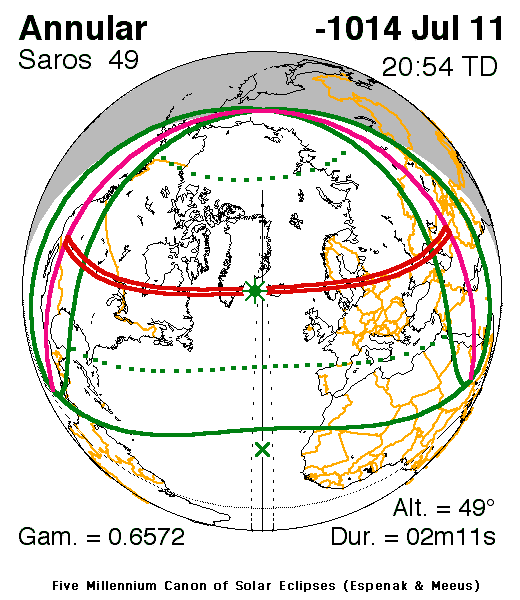An annular eclipse of the Sun occurred on 11 July, 1015 BC UT Old Style, with maximum eclipse at 13:47 UT. A large annular eclipse covered 97% of the Sun, creating a dramatic spectacle for observers in a path up to 129 km wide; it lasted 2 minutes and 11 seconds at the point of maximum eclipse.
The annular eclipse lasted for 2 minutes and 11 seconds.
Maximum eclipse was at 13:47:57 UT.
Overview Map
This map sourced from NASA Goddard Space flight Center: GSFC Eclipse Web SiteGSFC Eclipse Web Site
The primary source of all the information on eclipses presented here at Hermit Eclipse. (NASA Goddard Space flight Center)
shows the visibility of the annular solar eclipse. It also shows the broader area in which a partial eclipse was seen. (Click on it for the
full-sized version.)
Eclipse Season and Saros Series
This eclipse season contains 2 eclipses:
This was the 14th eclipse in solar Saros series 49.The surrounding eclipses in this Saros series are:
This Saros series, solar Saros series 49,
is linked to lunar Saros series 42. The
nearest partner eclipses in that series are:
Eclipse Parameters
| UT Date/time (max) | 13:47:57 on 11 Jul UT |
TDT Date/time (max) | 20:53:54 on 11 Jul TDT |
| Saros Series | 49 |
Number in Series | 14 |
| Penumbral Magnitiude | |
Central Magnitiude | 0.9731 |
| Gamma | 0.6573 |
Path Width (km) | 129 |
| Delta T | 7h06m |
Error | ± 21m13s (95%) |
| Penumbral Duration | |
Partial Duration | |
| Total Duration | 2m11s |
| |
| Partial Rating | |
Total Rating | |
Note that while all dates and times on this site (except
where noted) are in UT, which is within a second of civil time,
the dates and times shown in NASA's eclipse listingsGSFC Eclipse Web Site
The primary source of all the information on eclipses presented here at Hermit Eclipse. (NASA Goddard Space flight Center)
are in the TDT timescale.
Data last updated: 2015-06-21 22:11:40 UTC.

